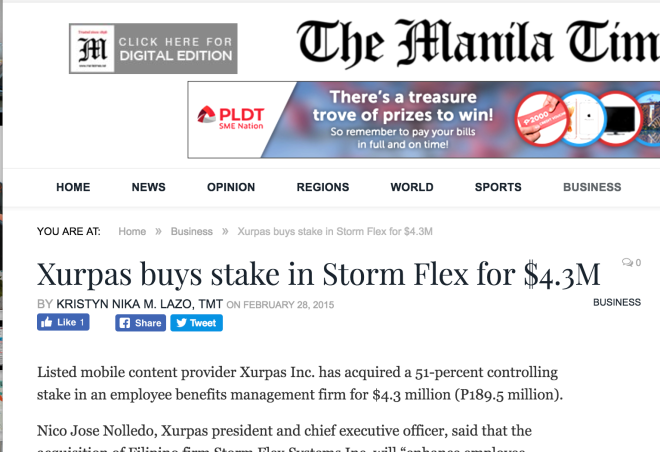
Years ago when I graduated, I had no special commendations. My grades were slightly above-average. Flunked one or two, if I remember right. I have no MBA. No special connections. I was raised in a middle-income family, where I contributed a portion of my earnings as a breadwinner along with my brother. I never got the chance to work abroad. I started my professional career out as a high school English teacher, and then entered corporate life as an HR Officer.
I remember slowly going up the corporate ladder. The frustration of it. The ups and downs. The multiple crises, quarter-life and otherwise. You know.
I remember refusing to have my dreams slowly snuffed out by reality though. I remember taking some leaps. Some small, some big.
Fast forward. STORM is now Philippines’ largest flexible benefits provider. It has since developed multiple enterprise products and will hit 100,000 employees on its platforms in 2017. It managed to raise P190 million in 2015. It is now starting to expand to other countries.
It is a Blessing. A literal dream come true.
I wanted to tell you the story of the three definitive leaps I took to take STORM from a startup founded in my living room to where it is now. It is my hope that you get see what I see: that if I managed to take these leaps, you can too.
First Leap: May 2005
My very first inspiration in doing a startup was boredom.
After some years in the HR track as a manager, I quickly got familiar with the cadence of the function. In typical companies, first quarter was when recruitment happened, it was when I visited the different campuses for job fairs and also the time when more veteran professionals looked for work (after bonus season). Second quarter was arranging the summer outing and midyear evaluations. Fourth quarter was the busiest with planning, final performance evaluations, and promotions. In between, I handled a whole bunch of people problems.
Year after year, it was like this.
I could forecast what EXACTLY what I’d be doing months ahead. Even after I’d get promoted or transfer companies, this cadence would soon catch up with me and I’d get bored out of my wits. There was also an underlying desperation that I tried to avoid confronting: was I TRAPPED in this career I had chosen?
Fortunately, I had this business idea I was excited about to keep me sane and professionally excited about something.
In the first (consulting) company I worked for, I was lucky to have been the project manager for one of the first flexible benefit systems implemented in the country. I tried to pitch it internally as a possible business line for the firm I worked with, but it was quickly rejected (“we won’t spend for a product with no clear market”).
This rejection galvanized me into thinking — hey, maybe I could do it myself!
I rationalized that for my idea to really be palatable to companies, I needed it to be a software product (as opposed to me being an implementations consultant).
Therefore, I needed a technical co-founder.
When I think about it now, the VERY FIRST leap I did was a small and innocuous one: a created a pitch deck using Powerpoint.
Then, I worked my ass off.
In 2005, the local Philippine startup ecosystem was nonexistent. There were no events to look for co-founders in. No Linkedin or Facebook. (as far as I recall, no one used Friendster then as a networking tool) I instead networked old-school (I asked my friends out for coffee and asked them if they knew anyone else interested) and used all my weekend mornings to talk to different people. Must’ve talked to over 50 people.
I lucked out and found the perfect partner, Paolo.
With an investment P30,000 each, we founded STORM and set up shop in my living room. Paolo went in fulltime immediately. Since I was breadwinner, I couldn’t afford the risk and contributed to STORM part-time. To save money, we set up the first office right inside my 1-bedroom condominium. We also begged for used furniture from our friends:

Again, I worked my ass off. I worked a fulltime job as an HR Director and spent nearly all of my spare time working on STORM.
Second Leap: July 2008
The company would grow SLOWLY over the next 2 years.
Then, during the summer of 2008, Paolo approached me and asked, “Dude, can I talk to you?”
“Can I talk to you” — never good news 🙂
After 3 years of STORM, Pao wanted to do something else.
In my mind, I thought STORM was done. After all, at that time we had just lost our biggest client (via fax!), and if Pao left, no one would run the show fulltime.
Wait, what if I go fulltime?
I would quickly block out and relegate thoughts like this as sheer folly.
After all, it was ALSO right smack in the middle of the global financial crisis. What’s the first budget that goes out the window for companies during a crunch? Yep, the HR budget.
But in my prayer time, taking this preposterous leap became a very powerful theme I couldn’t shake off.
I started to look at the numbers. They weren’t so encouraging.
Resigning and going full-time for STORM meant swallowing an 80–90% paycut during a year when my eldest, Joaquin was born.
During this particular time, the savings in my bank account was wiped clean when the person I loaned the amount in good faith disappeared.
I asked some of my wisest friends for advice. ALL of them said to wait it out. They understood my passion for STORM, but that I needed to wait this out. Perhaps I can let STORM die first, and then start again.
All logic told me to wait.
Instead, I followed this not-so-Small Voice in my heart.
With my wife’s support, I tendered my resignation and bid adieu to my HR Career.
It was the most traumatic and emotional career decision of my life.
It was also the absolute best one I ever made. (Thank God!)
January 2013: Third Leap
Sometime in 2009, Pao came back to STORM and together we began to organically grow the firm. This time was such a learning experience for me as an entrepreneur. It was all bootstrapped. In order for our families to have food on our tables, we needed to be a profitable business.
For the next 5 years, we would grow the company at a very steady pace.
Then, we hit a wall.
Up to this point, we were doing Flexible Benefits like our competitors did: as a software-as-a-service product. We would charge our clients a static monthly fee for use of our system. Employees on the platform would then use our system as a flexible reimbursement system: they would exchange their current benefits into basically, credit. They would then spend on the benefits of their choice using money from their own pocket, and then reimburse it thru our system.
This was a very useful model for us when we started because it gave us a very forecastable fiscal model.
However, this reimbursement-software-as-service model had many limitations: a) a lot of companies don’t have budgets for this sort of innovation on benefits b) the companies that did have budget had a lot of difficulty increasing this budget (we had difficulty negotiating rate increases even just to accommodate inflation) c) the reimbursement system created a whole lot of process problems (human error, reimbursement cheating, etc) d) you have to be financially liquid to use the system.
We then thought of a risky innovation: instead of using a reimbursement system, why can’t we create an internal BENEFITS MARKETPLACE? When people convert their current benefits, they can use the resulting wallet on a marketplace which STORM can offer.
Not only does this completely solve the process problems and the need for the employee to be liquid, but VERY IMPORTANTLY, this will allow us to change the business model. Instead of earning from the client company through monthly fees, we can instead earn from the benefit merchants through margins off of every benefit bought on the marketplace.
This allowed us to separate ourselves from competition by not only offering a superior, more relevant product, but also give us the ability to offer a fantastic value proposition: FREE.
The risks however, were very real: 1) we would have to raise money from the outside because we didn’t have enough money in the bank to execute a massive pivot like that, 2) we would be shifting from a business model that has kept us alive for many years, 3) there were no pegs ANYWHERE for us to learn if this could be done.
In the end, we decided to take a giant leap.
We raised an angel round and executed a successful pivot in 6 months. We then would proceed to quadruple revenue that year, laying the foundation for our bigger fundraise with Xurpas come 2015.

Leaps as a Way of Life
As an entrepreneur, one of the biggest realizations I’ve had in recent years is that in this Innovation Economy we live in, companies need to continually innovate (or die).
This is why STORM continues to invest in new and newer things. It’s why we decided not to rest on our laurels in 2013 and change the entire way we did business.
Very recently, we launched our newest product, Squares, which is something that’s VERY different from the other platforms we’ve been offering.
I think this approach needs to be inculcated individually, as well.
We live in an incredible time when technological revolutions happen on a blindingly fast pace. In order for any individual to capitalize and thrive in this environment, one has to be willing to risk and take leaps.
And if my experience is any indication, ANYONE can.
YOU can.
You just need to…
Take That First, Small Leap
I was never immediately someone who took large leaps.
My very first leap was to spend a few minutes crafting a pitch deck. Then this set me up for the next leap: pitching to potential co-founders on weekends. This allowed me enough momentum and courage for my next leap: parting with P30,000 and starting. Eventually, this paved the way for me quitting my HR career, and so on.
I am still VERY much in this pattern, eager to see the crossroads and opportunities which lie ahead.
Don’t let the world fool you into thinking your dreams are impractical exercises.
What’s your next leap?


